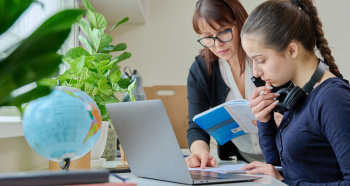We all know how important it is to look after wellbeing – learners’, teachers’ and our own. But how do you do that most effectively in your school? In this blog post we explain how you can make the most out of teaching wellbeing with the Cambridge Wellbeing Check, the Cambridge Primary and Lower Secondary Wellbeing curriculum frameworks and their supporting resources.
The University of Cambridge Primary School opened their doors, so we could work with 30 of their Year 5 students and demonstrate how to use all our resources together. Sarah Nelson, Curriculum Programmes Manager, Cambridge came with us to lead the activities with the learners. Sarah led the development of the Cambridge Primary and Lower Secondary wellbeing curriculum and is a former teacher.

Cambridge Wellbeing Check
We start with the Cambridge Wellbeing Check. This online assessment gives you a clear picture of wellbeing in your school. It equips you with the tools you need to evaluate, explore, teach and promote wellbeing with a lasting, positive impact. To sit a wellbeing check, learners log in to the programme online and answer a series of questions. The Cambridge Wellbeing Check explores four areas:
- Competence: The extent to which learners experience self-confidence, fulfilment and purpose
- Negative emotions: The extent to which learners feel worried, stressed and/or personal sadness
- Life satisfaction: The extent to which learners experience contentment and overall life satisfaction
- Interpersonal: The extent to which learners experience feeling connected to others in school, that those people care about them and that they are valued.
Sarah frames the use of the Cambridge Wellbeing Check within a lesson, which includes safeguarding. She refers the class to their class rules that they have agreed upon together to respect one another and keep each other safe. Sarah has produced a word-cloud print-out of a series of words describing emotional states and the class do an exercise on the frequency they feel those emotions.
The class then use a QR code to visit the Cambridge Wellbeing Check on their tablets. They log in with the details their teacher has given them on a printed out slip of paper (provided on a spreadsheet when the school purchases the Cambridge Wellbeing Check), answer all the questions and submit.
The system then provides a report based on the results, which the class teacher can review.
Watch the film of the learners using the Cambridge Wellbeing Check
Reviewing the Cambridge Wellbeing Check report

In our filmed example, Sarah and her colleague Dr Irenka Suto then review the results in an example conversation with one another. Dr Irenka Suto (Head of Secondary Curriculum Cambridge) led the development of the Cambridge Wellbeing Check. This is a conversation a class teacher could have with a senior member of staff responsible for school wellbeing or pastoral care. To protect the confidentiality of the learners for this assessment we analysed fictitious data.
Sarah prints off the results and she and Irenka look at the summary of the results. They then decide upon next steps for the fictional group of students. The results and the Cambridge Primary Wellbeing curriculum framework guide this conversation.
The results reveal that there is a low average score for competence wellbeing and a high average score for negative emotions. There are a couple of outlying results. One learner is showing particularly low scores for competence and higher score for negative emotions. Three learners are showing higher scores for competence and lower for negative emotions.
What is the plan?
This learning objective from the curriculum is identified as being helpful in this situation:
456Um.04 Practice a range of strategies they can use when self-managing unpleasant or intense emotions and identify which strategies they find most useful.
For the outlying results: No intervention is required for the three learners showing higher scores for competence and lower for negative emotions. Pastoral support is suggested for the one learner showing particularly low scores for competence.
You can find lots of support for teaching the Cambridge Primary Wellbeing and Cambridge Lower Secondary Wellbeing curriculum frameworks on the School Support Hub.
Watch the film of Sarah and Irenka’s discussion here
Teaching a lesson from the digital teacher’s resources
Sarah now leads an activity with a class of 30 learners on how to manage unpleasant emotions. Sarah teaches the activity from our digital teacher’s resources based on a specific learning objective from the curriculum.
The following 6-part lesson plan, aligned to the learning objective, was selected to teach to the class. You can view the full lesson plan here.
6-part lesson plan
- Story time (Duration 5 mins)
ACTIVITY: Listen to the Cambridge Reading Adventures story The Great Escape by Peter Millett.

Our guided reading series, Cambridge Reading Adventures, can be a helpful tool to teach learners about wellbeing through stories. We have mapped the whole series to our Cambridge wellbeing resources to make it easy for you to integrate them into your lessons.
While listening we asked learners to identify:
- What emotion is Selma feeling?
- Have you ever felt the way Selma felt? [Perhaps share examples of when.]
- Feelings thermometer (Duration 10 mins)
DISCUSSION: Introduce the ‘feelings thermometer’ to the learners.
A picture of a thermometer is displayed for learners. Learners are told ‘This is a thermometer that helps us understand how our emotions can be at different levels. For example, if I was feeling a little bit angry, I would be at number 1 on the thermometer (point to number 1). If I was feeling really, really angry I would be at number 5 (point to number 5)’.
A discussion around this thermometer then follows. For guidelines on this discussion please see the attached lesson plan.
- Breathing strategy (Duration 10 mins)
ACTIVITY: Ask learners to get in a comfortable position and explain that you are all going to practise a strategy that people use to help calm down.
For more details, please see the attached lesson plan.
- Alternative strategies carousel (Duration 25 mins)
Below are some examples of different types of strategies. Split the class into three groups and ask them to carousel around each one.
Rainbow grounding
Find items (in the classroom) for every colour of the rainbow.
This is called ‘Rainbow grounding’. It can help you to focus on the present moment when you feel overwhelmed.
Blow bubbles
Blowing bubbles forces you to pause, focus on a single activity and think about your breathing(similar impact to the earlier breathing exercise).
Bringing awareness to your body and grounding
Rub your hands together, wiggle your fingers and clap your hands three times. Wiggle your toes and stamp your feet three times firmly on the floor. Focus all your attention on your feet. Think about how your feet feel as they touch the ground / the bottom of your shoes.
Directing focus onto your physical body, particularly on the way our feet touch the ground, can help you to feel more secure and grounded. Also, the movement can help us calm down by releasing energy from our body.
DISCUSSION
For more details, please see the attached lesson plan.
- Find your own strategies (Duration 10 mins)
ACTIVITY: Ask learners to mind-map strategies that they feel would be most useful for them (they may already have their own strategies).
- Plenary (Duration 5 mins)
ACTIVITY: On a sticky note, ask learners to write down the strategy that they think would be most useful for them. All learners to add their sticky note to the board.
With these three steps, Sarah Nelson, Dr Irenka Suto and our Cambridge Wellbeing Check colleagues brought together the teaching of the wellbeing curriculum and supporting resources in the University Primary School. Learners were able to fulfil learning objective (456Um.04) and practise a range of strategies they can use when self-managing unpleasant or intense emotions and identify which strategies they found most useful.
To find out how to use our Cambridge Wellbeing Check with our curriculum frameworks, discover how our digital teaching resources are aligned to curricula learning objectives and explore the professional development available to support your teaching of wellbeing, read our wellbeing brochure.
Further reading, watching and listening!
Listen to our podcast on ‘Creating a Wellbeing Framework in your School’ on the Brighter Thinking Pod.
Watch the University of Cambridge Primary school carry out a forest school session. One of their strategies for looking after wellbeing at their school.





